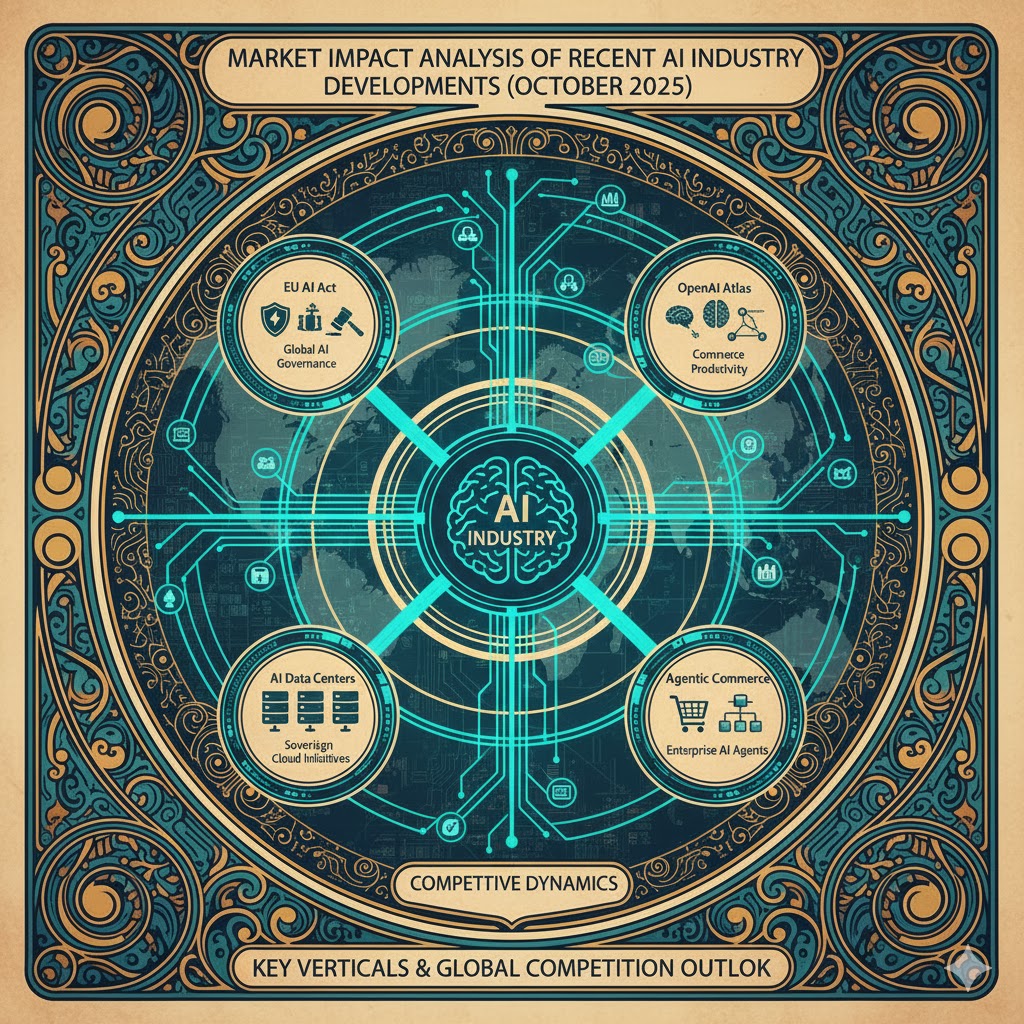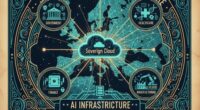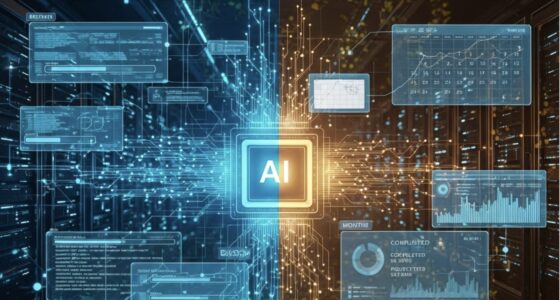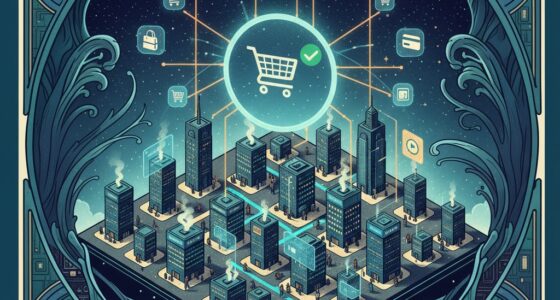Introduction
Four announcements made in October 2025 highlight the rapid escalation of infrastructure spending, commercial deployment and national strategy in artificial intelligence (AI):
- Anthropic’s long‑term compute deal with Google Cloud – Anthropic expanded its partnership with Google to access up to 1 million TPUs (Tensor Processing Units), securing more than 1 gigawatt of compute capacity coming online in 2026 and representing a contract worth tens of billions of dollarsreuters.comanthropic.com.
- Mondelez International’s generative‑AI advertising engine – the snack giant invested over US $40 million in a custom tool built with Publicis Groupe and Accenture. The company expects this system to cut advertising production costs by 30 – 50 % and plans to use it for short TV ads, digital assets on Amazon and Walmart, and social media contentreuters.com.
- OpenAI’s acquisition of Software Applications Inc. (makers of the Mac app Sky) – an AI‑native workflow assistant that integrates deeply with macOS. Sky can read what’s on a user’s screen and take actions within apps. OpenAI plans to integrate Sky’s capabilities into ChatGPT; the entire Sky team (ex‑Apple engineers behind the Workflow/Shortcuts app) joined OpenAItechcrunch.com.
- Argyll and SambaNova’s renewable‑powered sovereign AI cloud – Argyll Data Development announced a partnership with SambaNova Systems to build the UK’s first renewable‑powered AI inference cloud at the Killellan AI Growth Zone in Scotland. Phase 1 will provide 100–600 MW of AI compute, scaling to over 2 GW, using SambaNova’s air‑cooled SN40L systems that consume around one‑tenth the power of traditional GPU racksbusinesswire.com. Waste heat will be reused for vertical farming and district heatingbusinesswire.com.
- OpenAI’s South Korea Economic Blueprint – OpenAI released a 23 October 2025 blueprint urging South Korea to adopt a dual‑track strategy: develop sovereign AI models and infrastructure while simultaneously partnering with frontier AI providers. The Bank of Korea projects that AI could raise South Korea’s total factor productivity by 3.2 % and potentially boost GDP by 12.6 %cdn.openai.com. The government has pledged KRW 150 trillion (≈ US $115 billion) in AI investment and aims to become a top‑three AI powerhousecdn.openai.com. Key sectors targeted include smart manufacturing, healthcare, education/workforce and small‑to‑medium enterprisesopendatascience.com.
These developments illustrate how AI is maturing into a general‑purpose technology that touches infrastructure, consumer goods, software and national policy. Below we analyze the market impact, vertical opportunities, and competitive dynamics implied by each announcement.
1. Anthropic–Google Cloud Deal: Fueling the Compute Arms Race
Market Impact
- Scale of compute: Anthropic’s commitment to access up to 1 million TPUs signals one of the largest AI compute purchases to datereuters.com. This is roughly equivalent to more than a gigawatt of computing power, coming online in 2026reuters.com – comparable to Meta’s upcoming Hyperion data center which aims to deliver >2 GW of capacityreuters.com.
- Capital intensity: One gigawatt of AI computing can cost around US $50 billion according to industry estimates, and Reuters notes that OpenAI’s multiple compute deals may cost over $1 trillion to secure 26 GW of capacityreuters.com. Anthropic’s deal therefore fits into a trillion‑dollar race among OpenAI, Meta, Microsoft and others to acquire scarce AI chips and energy.
- Cloud infrastructure monetization: Google benefits by monetizing its in‑house TPU inventory; the partnership shifts demand away from Nvidia GPUs, which are supply constrained and expensive. Anthropic cited the price–performance and efficiency of TPUsreuters.com. Google thus strengthens its position as an alternative to Nvidia while continuing to supply TPU capacity to other firms via its Vertex AI cloud.
Vertical Implications and Benefits
| Vertical | Potential Benefits | Competitive Impact |
|---|---|---|
| Cloud Providers & Hardware | Demand for alternative AI accelerators (TPUs, AMD MI300X, Amazon Trainium) will grow as AI companies seek multi‑sourcing strategies. Google gains a marquee client, while Amazon retains Anthropic as a partner for its Project Rainier clusteranthropic.com. Nvidia faces pressure to keep pace on price/performance and supply. | Intensifies competition between hyperscalers (Google Cloud, AWS, Microsoft Azure) and dedicated compute providers such as CoreWeave. Anticipate more long‑term off‑take agreements to secure capacity, leading to consolidation among smaller providers. |
| Energy & Data Center Operators | Building >1 GW of AI compute requires grid‑scale energy. The supply–demand imbalance pushes hyperscalers to invest in renewable power procurement, battery storage and novel cooling (e.g., immersion). Demand will spill over into adjacent industries such as carbon‑free energy and power infrastructure. | Competitively, projects like Meta’s Hyperion (2 GW) and Argyll’s renewable AI cloud (2 GW) raise the bar. Operators that can integrate renewable generation and heat‑reuse (see Section 4) gain a differentiation advantage. |
| AI Service Providers & Model Training | Anthropic’s diversified compute strategy—using TPUs, Amazon Trainium and Nvidia GPUsanthropic.com—highlights a desire to avoid lock‑in. Enterprises may follow this approach when designing their own AI platforms. | The deal pressures other model developers (e.g., Cohere, Character.AI) to secure comparable compute volumes. It may encourage partnerships with alternative chipmakers (AMD, Graphcore) and open up opportunities for cloud brokers and spot-market compute platforms. |
| Application Verticals (Finance, Legal, Life Sciences) | More compute capacity enables larger and more specialized models. Anthropic already serves >300,000 business customers and saw a 7× increase in large accountsanthropic.com. Customers in regulated industries stand to benefit from improved model performance and alignment. | Competition will hinge on safety and reliability; Anthropic positions itself as an “enterprise‑first” providerreuters.com. Rivals like OpenAI, Cohere and Microsoft will need to differentiate on domain‑specific features and regulatory compliance. |
Broader Competitive Dynamics
The compute race underscores how AI infrastructure is becoming a moat. Securing supply of chips and energy is increasingly strategic; smaller AI developers may be forced to rely on the big cloud providers or join public–private compute initiatives. The collaboration also places Google in direct competition with Nvidia for AI accelerators while simultaneously deepening its partnership with Anthropic (which Amazon also backs). This triangular dynamic (Google–Anthropic–Amazon) illustrates how compute partnerships are overlapping and non‑exclusive.
2. Mondelez’s Generative‑AI Advertising Engine: Industrializing Creative Work
Market Impact
- Cost efficiency: Mondelez expects its AI tool to reduce ad‑production costs by 30 – 50 %reuters.com. With 2023 marketing expenditure of large consumer‑goods firms running into billions of dollars, similar cost savings at scale could free up hundreds of millions for other investments.
- Speed to market: The system can generate short TV ads and digital assets quickly, with the goal of producing content in time for the 2027 Super Bowlreuters.com. Accelerated creative cycles allow brand managers to respond in real‑time to cultural moments or market trends.
- Human oversight and ethics: Mondelez emphasises that humans will check AI outputs and that guidelines prohibit unhealthy or manipulative contentreuters.com. Such rules highlight the importance of responsible content generation as the technology scales.
Vertical Implications and Benefits
| Vertical | Potential Benefits | Competitive Impact |
|---|---|---|
| Advertising & Media | Automated generation of short videos, personalised images and texts reduces production times and costs. Agencies can redirect resources to strategy, brand storytelling and measurement. | Traditional ad agencies face disruption; some may pivot to AI‑augmented creative services or integrate generative AI platforms themselves. Competition may revolve around proprietary training data (brand assets) and content safety. |
| Consumer‑Packaged Goods (CPG) | Brands can run targeted campaigns across digital channels at scale. AI‑generated content can personalise product pages (e.g., Amazon, Walmart) and adapt to local preferences (e.g., Milka in Germany, Oreo in Brazil)reuters.com. | Early adopters like Mondelez, Kraft Heinz and Coca‑Cola could gain share through faster product launches and deeper consumer engagement. Smaller brands may partner with third‑party AI platforms to compete. |
| Broadcast & Streaming Platforms | Shortened production cycles may increase demand for ad inventory across streaming, retail media and social platforms. Advertisers might shift budgets from traditional agencies to self‑service AI platforms. | Streaming services could integrate creative‑as‑a‑service offerings to attract advertisers. Competition may spur new formats (interactive or shoppable ads) requiring regulatory guidance on transparency and fairness. |
| Technology Providers | Publicis Groupe and Accenture gain reference clients and may white‑label the platform for other brands. The market for generative‑AI marketing suites will expand, inviting entrants from Adobe, Canva and meta‑focusing startups. | Competition among service integrators will hinge on the quality of underlying models (image/video fidelity) and tools for brand control, auditability and integration with existing DAM/CRM systems. |
Broader Competitive Dynamics
Generative AI in marketing transitions from experimental to operational. The ability of a major CPG company to invest $40 million and embed AI into core processes sends a signal to peers. Agencies and production studios must adapt by offering AI‑enhanced creative services or risk disintermediation. Regulators will likely scrutinize generated content for consumer protection, privacy and intellectual‑property concerns.
3. OpenAI Acquires Software Applications Inc. (Sky): Moving AI From Browser to Desktop
Market Impact
- User‑centric workflows: Sky is an AI assistant that floats over the Mac desktop, understands what is on the user’s screen and can take actions in apps—writing, planning, coding and moretechcrunch.com. Integrating this with ChatGPT extends OpenAI’s reach beyond chat interfaces into the operating system.
- Talented team: The founders of Sky previously created the Workflow app (later Apple’s Shortcuts). Their experience embedding automation within iOS/macOS indicates that OpenAI sees deep integration as critical for mainstream adoptiontechcrunch.com.
- Competition with OS vendors: Apple is developing its own AI‑infused Siri and Apple Intelligence features but has not yet released a comparable agentic systemtechcrunch.com. Microsoft is also integrating Copilot directly into Windows. OpenAI’s move positions it as an independent layer atop operating systems.
Vertical Implications and Benefits
| Vertical | Potential Benefits | Competitive Impact |
|---|---|---|
| Productivity Software & Collaboration | Desktop agents could automate repetitive tasks (document formatting, scheduling, data entry) and provide context‑aware suggestions. Startups and enterprises may build plug‑ins that extend into specific workflows (coding, design, finance). | Traditional office suites (Microsoft Office, Google Workspace) face pressure to open their ecosystems to third‑party agents or accelerate their own embedded AI features. The competition will center on user trust, privacy, and integration depth. |
| Operating Systems | OS vendors may need to offer APIs that enable safe and efficient agentic interactions. The acquisition underscores the risk that non‑OS providers could capture the AI interface layer. | Apple, Microsoft and Google must balance openness with control; if OpenAI’s agent becomes ubiquitous, OSes could become commoditized. A battle over default AI assistants (similar to browser wars) may ensue. |
| Enterprise IT & Security | Agentic AI will require governance—screen‑reading and actioning raise privacy and compliance questions. Enterprises could benefit from improved productivity but must enforce data access policies. | Security vendors may develop tools to monitor and constrain agents. Competition may revolve around certification, auditing and integration with identity and access management systems. |
| Hardware & Accessories | Deep integration may spur demand for AI‑optimized chips in laptops and desktops. Accessory makers (headsets, cameras) could integrate sensors to provide context for agents. | Hardware vendors must collaborate with AI platform providers to optimize performance, battery life and connectivity. Those that partner with leading AI ecosystems may gain an edge. |
Broader Competitive Dynamics
OpenAI’s acquisition signals a shift from large language models as standalone apps to context‑aware agents that sit on top of the user’s environment. This blurs the line between application software and operating system. It could accelerate innovation in agentic AI, but also invites regulatory scrutiny over privacy and security. Apple’s own AI initiatives and Microsoft’s Copilot integration will compete to be the default AI layer on PCs. Expect rapid partnership announcements and acquisitions in the agentic‑assistant space.
4. Argyll & SambaNova’s Renewable‑Powered Sovereign AI Cloud: Energy Meets AI Sovereignty
Market Impact
- Sustainable compute: The Killellan AI Growth Zone will harness wind, wave and solar power to run SambaNova’s air‑cooled SN40L systems. Each rack consumes roughly one‑tenth the power of traditional GPU systemsbusinesswire.com. Waste heat will support vertical farming, aquaculture and local district heatingbusinesswire.com.
- Scale and economic impact: Phase 1 of the project will deliver 100–600 MW of compute capacity, scaling to >2 GW at full build‑outbusinesswire.com. It is expected to facilitate £15 billion in investment, create ≈2,000 construction jobs annually and 1,200 permanent positions, contributing £734 million in annual gross value added to the Scottish economybusinesswire.com.
- Data sovereignty: The infrastructure is designed to keep sensitive AI workloads within UK borders. Argyll emphasises that combining renewable power and high‑performance computing can make AI competitive, compliant and cost‑effectivebusinesswire.com.
Vertical Implications and Benefits
| Vertical | Potential Benefits | Competitive Impact |
|---|---|---|
| Data Center & Cloud Infrastructure | Demonstrates viability of large‑scale, renewable‑powered AI inference. Air‑cooled SN40L systems eliminate need for liquid cooling, reducing complexity and water use. | Competes with hyperscalers by offering sovereign, energy‑efficient alternatives. Encourages other regions (EU, Gulf States, Asia) to invest in sovereign AI clouds, potentially fragmenting the global cloud market. |
| Energy & Grid | Integration of wind, wave and solar with battery storage supports “island‑mode” operationbusinesswire.com, reducing reliance on fossil fuels. Heat‑reuse provides revenue and sustainability benefits. | Utilities and energy developers may partner with AI data‑centre operators to co-locate generation and compute. Competition may shift towards vertical integration of energy and compute services. |
| Government & National Security | Sovereign AI clouds enable governments to run sensitive workloads (defense, health, taxation) without relying on foreign hyperscalers. | Countries may race to build their own sovereign infrastructure. Nations lacking renewable resources or expertise may form alliances or buy capacity from providers like Argyll, raising questions about digital sovereignty and trade. |
| Semiconductor Providers | SambaNova’s custom silicon (SN40L) demonstrates energy‑efficient inference. If successful, it may accelerate adoption of alternative AI chips. | Nvidia’s dominance could face pressure as governments and enterprises explore non‑GPU options for cost and energy reasons. |
Broader Competitive Dynamics
This project shows that energy infrastructure and AI infrastructure are converging. The ability to secure renewable generation, efficient chips and localized governance becomes a competitive differentiator. Regions with abundant renewable resources could become AI hubs, while those lacking resources may import compute. The initiative also positions SambaNova as a partner of choice for governments seeking sovereign solutions.
5. OpenAI’s South Korea Economic Blueprint: National AI Strategy as a Competitive Tool
Market Impact
- Economic upside: The Bank of Korea estimates that AI could raise the country’s total factor productivity by 3.2 % and boost GDP growth by up to 12.6 %, a significant effect given the economy’s current ~2 % growth ratecdn.openai.com.
- Massive investment: The government plans to invest KRW 150 trillion (≈ US $115 billion) in AI through public–private collaborationcdn.openai.com.
- Dual‑track strategy: OpenAI recommends developing a sovereign AI ecosystem (models, infrastructure, data governance) while simultaneously partnering with frontier AI providers to accelerate adoptioncdn.openai.com. The strategy calls for targeted partnerships in domains with high impact and safety—such as SME productivity tools, healthcare copilots, education tutoring and smart manufacturingcdn.openai.com.
- Policy recommendations: The blueprint highlights the need for expanded compute capacity, interoperable data governance and real‑time monitoring frameworksopendatascience.com. It positions South Korea as an exporter of AI nation packages—combining technology, finance and regulatory modelsopendatascience.com.
Vertical Implications and Benefits
| Vertical | Potential Benefits | Competitive Impact |
|---|---|---|
| Semiconductor Manufacturing | Korea’s leadership in memory and logic chips (e.g., Samsung, SK Hynix) positions it to supply frontier AI hardware. Partnerships through the Stargate initiative aim to increase global AI infrastructurecdn.openai.com. | Strengthens Korea’s role in global AI supply chains. Could intensify competition with TSMC, Intel and Chinese foundries. |
| Smart Manufacturing & Exports | AI can reduce design cycles, improve yield and optimize supply chains in semiconductors, automotive and shipbuildingopendatascience.com. | Firms that adopt AI-driven automation will lead in efficiency; laggards may lose share. International competitors may replicate Korea’s dual‑track model. |
| Healthcare & Social Welfare | AI assistants for clinicians, administrative tasks and elderly care can improve efficiency and reduce errorscdn.openai.com. | Creates new markets for medical AI startups. Requires regulatory sandboxes and data‑privacy safeguards. |
| Education & Workforce | AI tutors and teaching copilots can personalize learning and build talent pipelinesopendatascience.com. | Ed‑tech companies and vocational institutions will compete to deliver AI‑enhanced curricula. Traditional education providers may have to modernize quickly. |
| Small & Medium Enterprises (SMEs) | Affordable AI assistants can handle paperwork, compliance and export documentationcdn.openai.com. | Levels the playing field by reducing fixed costs. Could disrupt business process outsourcing (BPO) providers. |
| Public Policy & Governance | Emphasises interoperable data frameworks, compute capacity and real‑time monitoringopendatascience.com. | Governments around the world may emulate the dual‑track strategy, seeking to balance sovereignty with global partnerships. |
Broader Competitive Dynamics
South Korea’s blueprint illustrates how national AI policy has become part of global economic competition. Nations with strong industrial bases and digital infrastructure can use AI to accelerate growth and export their regulatory models. The dual‑track strategy, combining sovereignty with collaboration, could influence other mid‑sized economies. For AI companies, aligning with national strategies may secure preferential access to talent, data and compute resources.
Cross‑Vertical Considerations and Competitive Landscape
- Infrastructure concentration and geopolitics: Anthropic’s and Meta’s deals highlight that gigawatt‑scale AI compute contracts are now multi‑billion‑dollar commitments. Access to chips, power and land has become a geopolitical asset. Sovereign AI clouds (Argyll) and national strategies (South Korea) signal that governments do not want to be entirely dependent on U.S. hyperscalers. This creates opportunities for regional data‑center builders, alternative chipmakers and green‑energy developers.
- Software vs. hardware moat: OpenAI’s acquisition of Sky shows that interface and workflow integration are the next battleground. Owning the agentic layer may prove as valuable as owning the model. Hardware vendors will compete to integrate with these agents, while software companies will need to expose APIs or risk displacement.
- Generative AI adoption beyond tech: Mondelez’s initiative demonstrates a tangible ROI for generative AI outside the tech sector. Other verticals—finance, legal, real estate—may develop their own generative tools. Competition will revolve around domain‑specific training data, adherence to ethics and regulatory compliance.
- Economic policy & global standard‑setting: OpenAI’s blueprint positions South Korea not just as an adopter but as a standard setter in AI. Countries able to couple investment, industrial policy and international partnerships may define norms around safety, data governance and trade. Firms that align early with emerging national frameworks may secure market access and subsidies.
Conclusion
October 2025’s string of AI announcements underscores the rapid fusion of technology, infrastructure, industry and geopolitics. Anthropic’s massive TPU contract accelerates the compute arms race; Mondelez’s generative‑AI engine shows enterprises monetizing AI for operational efficiency; OpenAI’s acquisition of Sky hints at a future where AI agents integrate deeply with operating systems; Argyll and SambaNova’s project demonstrates that AI compute can be sovereign and renewable; and OpenAI’s South Korea blueprint illustrates how national strategies are forming around AI. Together, these developments reveal that AI is no longer a niche technology but an economic and strategic platform whose benefits and competitive advantages will be captured by those who secure resources, integrate AI into workflows and align with emerging policy frameworks.









